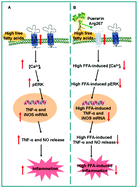A high concentration of fatty acids induces TNF-α as well as NO release mediated by the P2X4 receptor, and the protective effects of puerarin in RAW264.7 cells
Abstract
Circulating levels of free fatty acids (FFAs) are often found to be increased in patients with type 2 diabetes mellitus (T2DM) and metabolic syndrome (MS). High plasma FFA levels may give rise to maladaptive macrophage activation and promote inflammatory responses, which has been proposed as a potential mechanism for the development of DM and MS. P2X4 receptor (P2X4R), a ligand-gated cation channel activated by extracellular adenosine triphosphate (ATP), plays a primary role in the regulation of inflammatory responses. Puerarin has been reported to possess potential anti-inflammatory activity. However, the anti-inflammatory activity of puerarin and the underlying molecular mechanisms in a setting of a high concentration of FFAs remain unknown. In this study, we found that a high concentration of FFAs increased the expression of P2X4R, cytosolic Ca2+ concentration and the phosphorylation of extracellular signal-regulated kinase (ERK) and induced the expression of tumor necrosis factor (TNF)-α and inducible nitric oxide synthase (iNOS) mRNA and the release of TNF-α and nitric oxide (NO) in RAW264.7 macrophages. Such a high concentration FFA-induced inflammation may be reversed by the P2X4R selective antagonist 5-BDBD, which manifests the important role of P2X4R in the TNF-α and NO release caused by the high concentration of FFAs in RAW264.7 cells. Molecular docking data showed that puerarin could interfere with the activation of P2X4R by forming hydrogen bonding towards residue Arg267, an important residue essential for the canonical activation of P2X4R. Treatment with puerarin dose-dependently reduced high concentration FFA-elevated P2X4R expression and inhibited P2X4R-mediated inflammatory signalling, including high concentration FFA-evoked [Ca2+]i, ERK phosphorylation, expression of TNF-α and iNOS mRNA and release of TNF-α and NO. Our findings emphasize the critical role of P2X4R in high concentration FFA-induced TNF-α and NO release of RAW264.7 macrophages. Puerarin notably counteracts these high concentration FFA-induced adverse effects through its inhibition of P2X4R expression and P2X4R-mediated inflammatory signalling.



 Please wait while we load your content...
Please wait while we load your content...